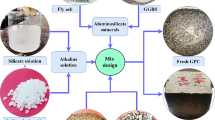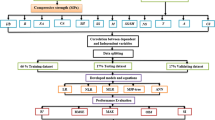Abstract
The need for the present decade is an environmentally friendly approach to the utilization of building materials. Geopolymers which are produced from 100% aluminosilicate-based waste materials have the potential to pave the path for sustainable development and construction practices. But many factors affect the compressive strength of geopolymers that needs to be evaluated before its utilization in any field practices. Hence the purpose of this article is to formulate a model by employing Artificial Neural Network (ANN) for prediction of compressive strength. Seven input parameters were taken into consideration which influences the compressive strength of geopolymers, to develop four different ANN models. A total of 396 sets of data were analyzed in training, validation, and testing phases to estimate the geopolymeric potential of different aluminosilicate-based precursors. The best performing model with an R2 value of 0.9994 is Model—4 which contains two hidden layers with 14 artificial neurons. Finally, ANN showed strong potential in predicting the compressive strength of geopolymers within the considered range.
Access this chapter
Tax calculation will be finalised at checkout
Purchases are for personal use only
Similar content being viewed by others
References
Al-Majidi MH et al (2016) Development of geopolymer mortar under ambient temperature for in situ applications. Constr Build Mater 120:198–211. https://doi.org/10.1016/j.conbuildmat.2016.05.085
Das SK (2018) Parametric study of flyash based geopolymer concrete. Int J Eng Technol (UAE) 7(2). https://doi.org/10.14419/ijet.v7i2.31.13439
Das SK, Sandeep S (2020) Siliceous fly ash and blast furnace slag based geopolymer concrete under ambient temperature curing condition. Struct Concrete suco.201900201. https://doi.org/10.1002/suco.201900201
Das SK, Sandeep S (2020) A study on the viability of fly ash and construction and demolition waste as geopolymerized masonry mortar and their comparative analysis. Mater Today: Proc 32(4):574–583, Elsevier Ltd. https://doi.org/10.1016/j.matpr.2020.02.402
Duan ZH et al (2013) Using artificial neural networks for predicting the elastic modulus of recycled aggregate concrete. Constr Build Mater 44:524–532. https://doi.org/10.1016/j.conbuildmat.2013.02.064
Eskandari-Naddaf H, Kazemi R (2017) ANN prediction of cement mortar compressive strength, influence of cement strength class. Constr Build Mater 138:1–11. https://doi.org/10.1016/j.conbuildmat.2017.01.132
Haddad R, Haddad M (2020) Predicting fiber‐reinforced polymer–concrete bond strength using artificial neural networks: a comparative analysis study. Struct Concrete suco.201900298. https://doi.org/10.1002/suco.201900298
Hammoudi A et al (2019) Comparison of Artificial Neural Network (ANN) and Response Surface Methodology (RSM) prediction in compressive strength of recycled concrete aggregates. Constr Build Mater 209:425–436. https://doi.org/10.1016/j.conbuildmat.2019.03.119
Kellouche Y et al (2019) Exploring the major factors affecting fly-ash concrete carbonation using artificial neural network. Neural Comput Appl 31(S2):969–988. https://doi.org/10.1007/s00521-017-3052-2
Koenig A et al (2017) Resistance of alkali-activated binders to organic acid attack: assessment of evaluation criteria and damage mechanisms. Constr Build Mater 151:405–413. https://doi.org/10.1016/j.conbuildmat.2017.06.117
Liu SW et al (2002) Detection of cracks using neural networks and computational mechanics. Comput Methods Appl Mech Eng 191(25–26):2831–2845. https://doi.org/10.1016/S0045-7825(02)00221-9
Madani H et al (2020) Geopolymer bricks made from less active waste materials. Constr Build Mater 247:118441. https://doi.org/10.1016/j.conbuildmat.2020.118441
Murat Günaydın H, Zeynep Doğan S (2004) A neural network approach for early cost estimation of structural systems of buildings. Int J Project Manag 22(7):595–602. https://doi.org/10.1016/j.ijproman.2004.04.002
Nagajothi S, Elavenil S (2020) Influence of aluminosilicate for the prediction of mechanical properties of geopolymer concrete—artificial neural network. SILICON 12(5):1011–1021. https://doi.org/10.1007/s12633-019-00203-8
Nazari A, Torgal FP (2013) Predicting compressive strength of different geopolymers by artificial neural networks. Ceram Int 39(3):2247–2257. https://doi.org/10.1016/j.ceramint.2012.08.070
Nazari A, Riahi S (2011) Prediction split tensile strength and water permeability of high strength concrete containing TiO2 Nanoparticles by artificial neural network and genetic programming. Compos B Eng 42(3):473–488. https://doi.org/10.1016/j.compositesb.2010.12.004
Ng C et al (2018) A review on microstructural study and compressive strength of geopolymer mortar, paste and concrete. Constr Build Mater 186:550–576. https://doi.org/10.1016/j.conbuildmat.2018.07.075
Niibori Y et al (2000) Dissolution rates of amorphous silica in highly alakline solution. J Nuclear Sci Technol 37(4):349–357. https://doi.org/10.1080/18811248.2000.9714905
Öztaş A et al (2006) Predicting the compressive strength and slump of high strength concrete using neural network. Constr Build Mater 20(9):769–775. https://doi.org/10.1016/j.conbuildmat.2005.01.054
Pala M et al (2007) Appraisal of long-term effects of fly ash and silica fume on compressive strength of concrete by neural networks. Constr Build Mater 21(2):384–394. https://doi.org/10.1016/j.conbuildmat.2005.08.009
Phoo-ngernkham T et al (2015) Effects of sodium hydroxide and sodium silicate solutions on compressive and shear bond strengths of FA–GBFS geopolymer. Constr Build Mater 91:1–8. https://doi.org/10.1016/j.conbuildmat.2015.05.001
Pilehvar S et al (2018) Physical and mechanical properties of fly ash and slag geopolymer concrete containing different types of micro-encapsulated phase change materials. Constr Build Mater 173:28–39. https://doi.org/10.1016/j.conbuildmat.2018.04.016
Rajeshwari R, Mandal S (2019) Prediction of compressive strength of high-volume fly ash concrete using artificial neural network. Lect Notes Civil Eng 25:471–483. https://doi.org/10.1007/978-981-13-3317-0_42
Reggiani A (2019) Geopolymer roof tile. Ceram Eng Sci Proc 39(3):225–232. https://doi.org/10.1002/9781119543381.ch20
Sarıdemir M (2009) Prediction of compressive strength of concretes containing metakaolin and silica fume by artificial neural networks. Adv Eng Softw 40(5):350–355. https://doi.org/10.1016/j.advengsoft.2008.05.002
Siddique R et al (2011) Prediction of compressive strength of self-compacting concrete containing bottom ash using artificial neural networks. Adv Eng Softw 42(10):780–786, https://doi.org/10.1016/j.advengsoft.2011.05.016
Topçu İB, and Mustafa S (2008) Prediction of compressive strength of concrete containing fly ash using artificial neural networks and fuzzy logic. Comput Mater Sci 41(3):305–311. https://doi.org/10.1016/j.commatsci.2007.04.009
Yadollahi MM et al (2015) Prediction of compressive strength of geopolymer composites using an artificial neural network. Mater Res Innov 19(6):453–458. https://doi.org/10.1179/1433075X15Y.0000000020
Author information
Authors and Affiliations
Corresponding author
Editor information
Editors and Affiliations
Rights and permissions
Copyright information
© 2022 The Author(s), under exclusive license to Springer Nature Singapore Pte Ltd.
About this chapter
Cite this chapter
Das, S.K., Shrivastava, S. (2022). Compressive Strength Prediction of Aluminosilicate Precursors Based Geopolymers Through Artificial Neural Network (ANN). In: Das, B.B., Gomez, C.P., Mohapatra, B.G. (eds) Recent Developments in Sustainable Infrastructure (ICRDSI-2020)—Structure and Construction Management. Lecture Notes in Civil Engineering, vol 221. Springer, Singapore. https://doi.org/10.1007/978-981-16-8433-3_3
Download citation
DOI: https://doi.org/10.1007/978-981-16-8433-3_3
Published:
Publisher Name: Springer, Singapore
Print ISBN: 978-981-16-8432-6
Online ISBN: 978-981-16-8433-3
eBook Packages: EngineeringEngineering (R0)




